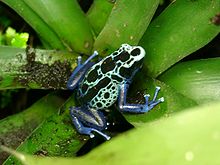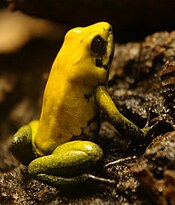| Dendrobatinae | |
|---|---|

| |
| Dyeing dart frog, Dendrobates tinctorius. | |
| Scientific classification | |
| Domain: | Eukaryota |
| Kingdom: | Animalia |
| Phylum: | Chordata |
| Class: | Amphibia |
| Order: | Anura |
| Family: | Dendrobatidae |
| Subfamily: | Dendrobatinae Cope, 1865 |
| Genera | |
|
Adelphobates | |
Dendrobatinae is the main subfamily of frogs in the family Dendrobatidae, the poison dart frogs of Central and South America, found from Nicaragua to the Amazon basin in Brazil.
Description
Dendrobatinae are generally small frogs; Andinobates minutus is as small as 13–16 mm (0.51–0.63 in) in snout–vent length. Many species are brightly colored and all are toxic. Alkaloids in Phyllobates are particularly potent.
All species are presumed to show parental care, often by the male. However, some species show biparental care (Ranitomeya), whereas in Oophaga only females care for the tadpoles, feeding them with eggs, their only source of nutrition. The males are responsible for protecting the eggs from predation and keeping the eggs from drying out by urinating on them.
General
There are eight or seven genera in this subfamily:
| Image | Genus | Living species |
|---|---|---|
 |
Adelphobates Grant, Frost, Caldwell, Gagliardo, Haddad, Kok, Means, Noonan, Schargel, and Wheeler, 2006 |
|
 |
Andinobates Twomey, Brown, Amézquita, and Mejía-Vargas, 2011 |
|
 |
Dendrobates Wagler, 1830 |
|
 |
Excidobates Twomey and Brown, 2008 |
|
| Minyobates Myers, 1987 |
| |
 |
Oophaga Bauer, 1994 |
|
 |
Phyllobates Duméril and Bibron, 1841 |
P. lugubris species group
P. bicolor species group
|
 |
Ranitomeya Bauer, 1986 |
|
The most specious genera are Ranitomeya (16 species) and Andinobates (13 species). Dendrobates used to be much larger but currently contains only five species, having had most of its species split off into genera erected later.
References
- ^ Frost, Darrel R. (2014). "Dendrobatinae Cope, 1865". Amphibian Species of the World: an Online Reference. Version 6.0. American Museum of Natural History. Retrieved 13 September 2014.
- ^ Vitt, Laurie J.; Caldwell, Janalee P. (2014). Herpetology: An Introductory Biology of Amphibians and Reptiles (4th ed.). Academic Press. pp. 489–490.
- ^ "Dendrobatidae". AmphibiaWeb: Information on amphibian biology and conservation. . Berkeley, California: AmphibiaWeb. 2014. Retrieved 13 September 2014. AmphibiaWeb is not placing Andinobates in any subfamily.
- Brust, D. G. (1993). "Maternal Brood Care by Dendrobates pumilio: A Frog that Feeds its Young", Journal of Herpetology. Vol. 27, No. 1. pp. 96–98.
- "Google Translate". google.com.
- Grant, T.; Frost, D. R.; Caldwell, J. P.; Gagliardo, R.; Haddad, C. F. B.; Kok, P. J. R.; Means, D. B.; Noonan, B. P.; Schargel, W. E. & Wheeler, W. C. (2006). "Phylogenetic systematics of dart-poison frogs and their relatives (Amphibia: Athesphatanura: Dendrobatidae)" (PDF). Bulletin of the American Museum of Natural History. 299: 1–262. doi:10.1206/0003-0090(2006)299[1:PSODFA]2.0.CO;2.
| Taxon identifiers | |
|---|---|
| Dendrobatinae | |